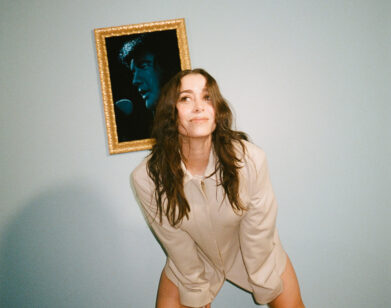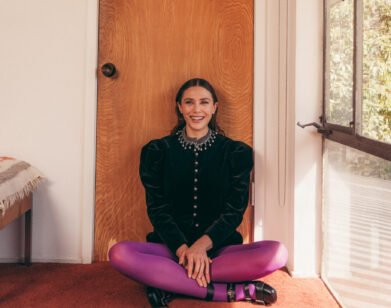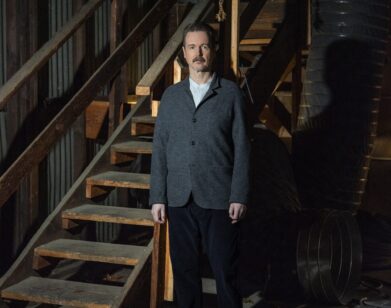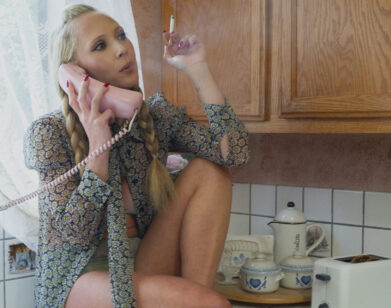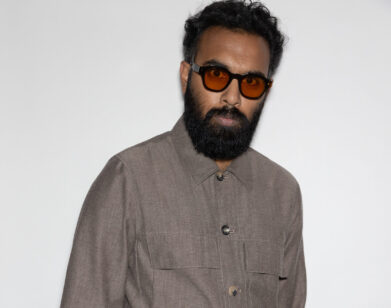Elena Anaya and That Mysterious Skin
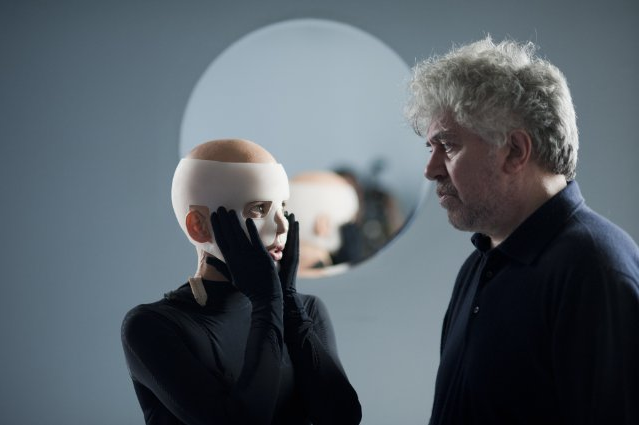
ELENA ANAYA (LEFT) WITH PEDRO ALMODÓVAR ON THE SET OF THE SKIN I LIVE IN.
In Pedro Almodóvar’s mad-scientist flick The Skin I Live In, Elena Anaya plays Vera, the serene but intense prisoner and test specimen of Dr. Robert Ledgard (Antonio Banderas), a plastic surgeon who lost his wife in a car crash. Vera’s life is lived in a large room, alone, her meals delivered to her. Yoga is her only escape. Since the death of Dr. Ledgard’s wife, he was been working tirelessly toward developing a new skin, using Vera as the prototype.
But how did Vera get there? Almodóvar travels back and forth in time, unraveling the backstories of each character and pushing the limits of faith and imagination at each step. We spoke to Anaya on the eve of the film’s release about working with Almodóvar and her flesh-colored bodysuit.
CRAIG HUBERT: How are you doing?
ELENA ANAYA: Very well. Just being in New York, it feels good.
HUBERT: This is the second time you’ve worked with Pedro. What was different about the process this time?
ANAYA: Well, this time I got, like, the whole trip, you know? In Talk to Her, it was a very brief collaboration. There we basically had a day—he talked to me about the character, and then we shot two days, little scenes. Here, we had to go through the whole journey together. And I found the same Pedro, with the same passion. He gives himself entirely to his work.
HUBERT: I understand Pedro gave you a lot of notes before making the film. What do those notes consist of?
ANAYA: The first thing he gave me was a few lines of an Elias Canetti book called The Book of Death, I guess, in English. Libro de los Muertos. It was about a white animal, a leopard or something, inside of a jail, walking so patiently, waiting and waiting, walking from one side of the jail to the other—until there is a brief, tiny opportunity to escape. It was the introduction to my character. I was that leopard, walking that jail, learning how to wait for six years until this opportunity comes. That’s where the film starts.
HUBERT: Pedro mentions Hitchcock and some other filmmakers as inspirations for the film. Did Pedro give you any films to look at?
ANAYA: Of course, yeah. We looked at the Franju film, The Eyes with No Face. He wanted me to look at noir films—like Barbara Stanwyck, Baby Face, Otto Preminger, Double Indemnity. Those women are tiny; they were not big, but very powerful. Just with an eyebrow they said, “This is my man, don’t touch him.” Without moving a muscle.
And Pedro asked me to do yoga, like crazy. He does yoga with the same teacher I worked with.
HUBERT: How far in advance did you have to start doing yoga?
ANAYA: Three months before we started the film. That was interesting to me, because I learned the whole process. I’ve never done yoga before. I kind of explored in myself the enormous strength that a discipline like that offers you.
HUBERT: The film has a lot of twists and turns. When you got the script, were you nervous it would hard to understand, or the material controversial?
ANAYA: Before I read the script, I spent one afternoon with Pedro taking thousands of notes, and he explained to me everything: why he wanted to make this film, what this film is talking about, why he wants me in the film, what he wanted to get from my performance. Then I read it, and it went even further. I had the feeling that—the script really overwhelmed me, I was deeply touched. And I admire him in a beautiful way, you know? He was talking about something in a way nobody else has done before. The way he goes from one thing to another, bringing so many things at the same time, and he’s talking about so many things. I was so surprised by the way he wrote the script, how he departs from one moment, and then you go up, up, up—and at a certain point, when the questions are answered, you go [makes “whoosh” sound]. You are taken.
HUBERT: Many actors return to work with Pedro again and again. How was the atmosphere on set?
ANAYA: Everyone seems to know each other, because they belong to the same family. The atmosphere on this film was brilliant. I think Pedro set an incredible mood—he was very happy with the story, and he felt comfortable. And we were all into the story. Between the takes, with the humor, and the laughing, is the best way to get rid of tension. The dark atmosphere of what we were talking about, it was easy to mix up—to go in and out.
If it happens that I work with him again, I’ll be thrilled. For me, this film means a lot. I don’t think I need to give explanations why. [laughs] But it was even better than I expected.
HUBERT: You talked a little about your preparation for the film with the notes Pedro gave you, but was there any other physical preparation besides the yoga? There are some intense fight scenes in the film.
ANAYA: Yeah, those things all need choreography, otherwise you get bruises and you can, you know, feel pain. [laughs] The physical scenes, I needed to be relaxed. And you need the partner to be an important help. That’s why I’m glad I had the best one, Roberto Alamo, the actor, who I’ve known well for many years.
HUBERT: What was it like working with Antonio?
ANAYA: You know, Antonio—it’s so transparent. He’s an actor in fiction because in real life he doesn’t know how to act. I mean, he knows how to behave as a human. He’s such an incredible guy. He’s so generous and professional. He has the most incredible energy as well. He brings you up when you are done for the day and you need two more hours. He’s great at being very quiet and dark when he needed, and then being the most sweet and funny and light person.
HUBERT: It was a big deal that he was working with Pedro again.
ANAYA: Oh yes. We dreamed of that. I was expecting that to happen for years, and then it happens in front of my eyes.
HUBERT: Did you grow up watching their films together?
ANAYA: Of course, yeah, they belong to our story. I grew up with those films. Those films are iconic in my culture. Pedro broke boundaries during the period he was making those films. He was able to tell stories nobody was able to before. But also, he opened people’s eyes to being yourself and to enjoy freedom.
HUBERT: I feel like it wouldn’t be right if I didn’t ask you about the body suit you wear throughout the film. I imagine that had to be difficult to wear. It is revealing.
ANAYA: I loved it. It helps a lot. You get the idea, immediately, about this character feels. It’s almost an artificial skin. You can be nude and feel very exposed, but with that thing, it goes farther. It makes you feel like you’re living inside skin that doesn’t belong to you, like you’re trapped.
HUBERT: Was it comfortable to wear?
ANAYA: It was. It was a little slippery, so we have to put stuff on my feet to not get killed on the stairs. We were a little scared because summer in Spain, in Toledo where we shot, was very hot. I could have died.
THE SKIN I LIVE IN IS OUT IN LIMITED RELEASE TODAY.

